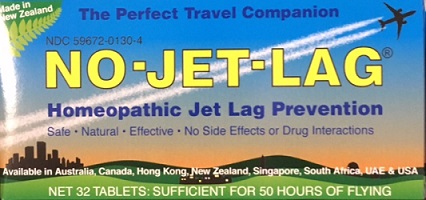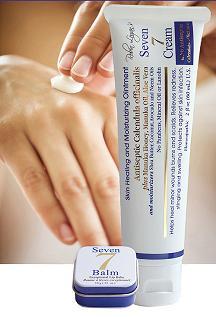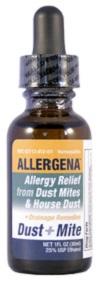Description
No-Jet-Lag ®
The Leader in Jet Lag Management for over 25 years
Jet lag is the curse of modern jet travel, but it doesn´t have to spoil your trip.
The unique homeopathic remedy No-Jet-Lag helps ensure holiday enjoyment and working efficiency even after long airline flights.
No-Jet-Lag is raved about by satisfied travelers globally, including business executives, sports teams, tour operators, and flight crews. It is safe and easy to take, and according to surveys and various testings, it has shown to be helpful to people who use it.
INGREDIENTS:
Arnica montana 30C (arnica flowers)
Bellis perennis 30C (daisy)
Chamomilla 30C (camomille)
Ipecacuanha 30C (ipecac root)
Lycopodium 30C (club moss)
32 TABLETS…sufficient for 50 hours of flying!
A survey was carried out in 1994 among New Zealand based flight attendants regularly flying routes to Asia, the United States and Europe, with the assistance of their union – F.A.R.S.A. They were asked how many suffered from jet lag, what symptoms they suffered, and whether No-Jet-Lag was effective in countering them.
A total of 228 flight attendants completed survey forms, giving the following responses:
Have you suffered from jet lag while travelling on long distance flights?
– Yes = 96%
– No = 4%
Specifically have you suffered from:
– Tiredness over the first five days after arrival = 90% yes
– Disorientation = 53% yes
– Dehydration = 73% yes
– Lack of energy and motivation = 94% yes
– Swelling of limbs = 32% yes
– Broken sleep after arrival = 93% yes
– Ear, nose, throat problems, colds or flu = 70% yes
How effective was No-Jet-Lag in countering jet lag symptoms for you?
– Very good = 32%
– Good = 43%
– Fair = 23%
– Made no real difference = 2%
Did you find No-Jet-Lag effective in countering tiredness after arrival?
– Yes = 87%
– No = 13%
Note: A US based survey found that 94% of long distance travellers suffered from the effects of jet lag and that 45% considered those symptoms severely bothersome.
Full text as published in Volume 69, number 8, August 1998 edition of Aviation, Space and Environment Medicine (Official Journal of the Aerospace Medical Association).
Do professionals get jet lag?
A commentary on Jet Lag
A survey was carried out among New Zealand-based flight attendants regularly flying international passenger routes to Asia, the United States and Europe, to determine how many suffered from jet lag and what symptoms they experienced. The survey was conducted with a view to identifying the symptoms that might most appropriately be targeted by a preparation designed to alleviate jet lag among flight crew.
The survey was carried out by Miers Laboratories, a New Zealand company which designs and markets homeopathic preparations. The questionnaire also invited respondents to comment on the efficacy of a preparation designed to counter jet lag. (This was not a formal trial; results of an independent controlled trial are currently in preparation for publication.)
Jet lag is widely considered to be a curse of modern jet travel, resulting in loss of working efficiency and holiday enjoyment, often for days after arrival at destination.
A number of studies have shown that over 90% of long distance travelers suffer from the effects of jet lag. A major US study of long distance travelers with United Airlines and British Airways found that 94% suffered jet-lag symptoms, and 45% considered their symptoms severely bothersome (2).
An objective of our survey was to ascertain whether airline personnel, who might be expected to have developed an “immunity” to jet lag and to be aware of practical methods to counter some of its effects, suffered the same symptoms as passengers.
Jet lag is typically characterized by a number of well-known symptoms easily recognized by the sufferer. They include:
Disruption to circadian rhythms caused by crossing time zones, which can result in broken sleep, with the sufferer waking during the night and then wanting to fall asleep during the day. The number of days this dysrhythmia lasts has been observed to be about equal to the number of time zones crossed. A study by Air New Zealand states that passengers crossing 12 times zones on a 26-hour flight require ten days to re-establish a normal sleep pattern (1).
Fatigue, lasting for days after arrival. This is often accompanied by a lack of concentration and motivation, especially for any activity that requires effort or skill, such as driving, concentrated reading or business negotiation.
Disorientation and vagueness. Respondents in our survey mentioned, for example, having to return to their hotel room three times to check if they had left the door locked.
In addition to the above symptoms of jet lag proper, the syndrome is made worse by the physical effects of being confined in an airliner for hours:
Discomfort of legs and feet due to limbs swelling while flying, which in some cases can prevent travellers wearing their normal shoes for up to 24 hours after arrival.
Dehydration due to the dry atmosphere aboard airliners, which can cause headaches, dry skin and nasal irritation. This in turn can result in a general feeling of unwellness and make the subject more susceptible to colds or other infections.
The World Health Organization also cites jet lag as an aggravating factor in cases of diarrhoea caused by microbiological contamination of water or food, which it believes affects between 20% and 50% of travellers (3).
Since the biggest single cause of jet lag is crossing time zones, which disrupts the body’s circadian rhythms, the syndrome is most severely felt when associated with east-west, west-east or transpolar flights. The effects are made worse by variations in atmospheric pressure each time the aircraft takes off and lands, and also by pre-flight stress, tiredness or hangovers. Other factors that appear to exacerbate jet lag include the dryness of the air supply aboard passenger aircraft, the temptation to consume alcohol and to eat more than necessary during flight, and the lack of body movement, especially in the legs and feet.
In our survey of New Zealand-based flight attendants rostered on inter-continental flights, a questionnaire was sent to all long-haul members of their union, the Flight Attendants and Related Services Association, with an explanation of the purposes for which the research was being carried out. Participation was voluntary, and 228 forms were returned. The union facilitated the survey and encouraged members to participate but did not attempt to influence the responses, which were mailed direct to Miers Laboratories for analysis.
In response to the first question, “Have you suffered from jet lag while traveling on long distance flights?” a high 96% said “yes”, a result which is in line with responses in surveys of long-haul passengers. This would tend to indicate that being regularly exposed to and trained to cope with the strains of long-haul air travel does not diminish the likelihood of experiencing jet lag. However, the survey did not attempt to quantify the severity of the symptoms of flight crew as compared with passengers.
Flight attendants were then asked whether they commonly experienced specific symptoms of jet lag during and after long-haul flights. Their responses were as follows:
Tiredness over the first five days after arrival, 90%.
Interrupted sleep after arrival, 93%.
Lack of energy and motivation, 94%.
Disorientation, 53%.
Dehydration, 73%.
Swelling of limbs, 32%.
Ear, nose, throat problems, colds or flu, 70%.
Circadian dysrhythmia is thus experienced by about the same proportion of flying professionals as of passengers. This appears to contradict the often heard claim that frequent travelers develop an ability to overcome this problem.
Another noteworthy finding was that a very high 73% of flight attendants experienced dehydration. Dehydration in flight can be largely countered by regular drinking of water (as distinct from alcohol, coffee, fruit juice, etc), and it appears the flight attendants had either not been told of this in training or were not following recommended practice.
Also surprising was that 32% of flight attendants experienced swelling of limbs, a symptom generally attributed to passenger immobility during long flights. This may indicate that other factors such as changes in air pressure or dehydration contribute to limb swelling.
In answer to the question “how effective was the homeopathic preparation, No-Jet-Lag in countering jet lag symptoms,” 75% of the 55 flight attendants who used No-Jet-Lag said it was either good or very good in countering jet lag symptoms.
REFERENCES
1. Petrie K, Conaglen JV, Thompson L, Chamberlain K. Effect of melatonin on jet lag after long haul flights. British Medical Journal 1989; 298:705-707.
2. The Upjohn Company. Tips for Overcoming Jet Lag (leaflet). Kalamazoo, mi: The Upjohn Co., nd.
3. WHO, Geneva. Safe Food for Travellers: WHO’s Recommendations (leaflet). 28 June 1994.
** When referencing this study give credit to Miers Laboratories jet lag site, www.nojetlag.com
HOW TO REDUCE JET LAG
Use No-Jet-Lag
This is a safe and effective remedy for countering jet lag, in the form of easy-to-take tablets. Its effectiveness has been proved in a scientific trial of round-the-world passengers and confirmed by longhaul flight attendants in a test conducted in cooperation with their union. Being a homeopathic preparation using extremely low dosages, No-Jet-Lag has no side effects and is compatible with other medications. It has no connection with the controversial hormone melatonin.
Pre-flight
This is one of the most important aspects of combating jet lag. Before departing, make sure you have all your affairs, business and personal, in order. Ensure you are not stressed-out with excitement or worry, and not tired or hungover from a function the night before. Get plenty of exercise in the days prior to departure and try to avoid sickness such as the flu, colds and so on. If you have a cold, flying will probably make it worse – ideally you should delay the trip. Get a good night’s sleep just prior to departure.
East or west?
There is much debate about whether it is better to fly eastward or westward. It may be largely a matter of personal preference, but there is some evidence that flying westwards causes less jet lag than flying eastwards.
Night or day flight?
Again it is largely a matter of personal preference based on experience. Most travelers think daytime flights cause less jet lag. We note that more daytime long haul flights are being added by major airlines.
Drinking fluids
The dry air in aircraft causes dehydration. Drinking plenty of non-alcoholic fluids counters this. Water is better than coffee, tea and fruit juices. Alcohol not only is useless in combating dehydration, but has a markedly greater intoxicating effect when drunk in the rarefied atmosphere of an airliner than it does at ground level.
Sleeping aids
Blindfolds, ear plugs, neckrests and blow-up pillows are all useful in helping you get quality sleep while flying. Kick your shoes off to ease pressure on the feet (some airlines provide soft sock-like slippers, and many experienced travelers carry their own).
Exercise
Get as much exercise as you can. Walking up and down the aisle, standing for spells, and doing small twisting and stretching exercises in your seat all help to reduce discomfort, especially swelling of legs and feet. Get off the plane if possible at stopovers, and do some exercises or take a walk. This also helps to reduce the possibility of blood clots and associated trauma.
Showers
During extended stopovers on a longhaul flight, showers are sometimes available. A shower not only freshens you up but gets the muscles and circulation going again and makes you feel much better for the rest of the flight. Trans-Pacific pilots have told us taking a shower in Hawaii helps them recover more quickly from the general effects of jet lag after the flight.
Melatonin
This is a controversial and complex treatment for jet lag involving the manipulation of a hormone in the body, starting in the days preceding travel. Research shows that if you miscalculate the right time to take it, melatonin will actually make jet lag worse! And for research that casts doubt on whether melatonin does counter jet lag click here.
Anti jet lag diet
Another complicated method is the anti jet lag diet. Like melatonin, this is for people with lots of time on their hands who can devote several days before and after a trip to preparing. Although it has some passionate devotees it is complicated and there is little evidence that it works.
Sleeping pills (don’t!)
Some people use sleeping tablets to try to alleviate jet lag. This is a dangerous approach as sleeping pills induce a comatose state with little or no natural body movement, and it is well known that prolonged immobility during flight can lead to fatal blood clots (deep vein thrombosis). This was reported as far back as 1988 in the Lancet, which said it was estimated “that over three years at Heathrow Airport, 18% of the 61 sudden deaths in long distance passengers were caused by clots in the lungs.” Picture the leg veins as bags of blood. When this blood doesn’t circulate there is a risk that it will clot. In addition, many so-called sleeping pills are variants on anti-histamines and they tend to dehydrate significantly, adding to the already significant problem of in-flight dehydration.






Reviews
There are no reviews yet.